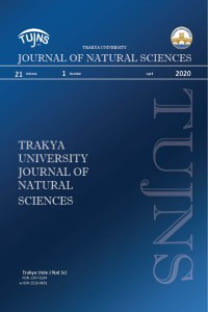Prunella vulgaris L. VE Prunella grandiflora L.’DEN SAFLAŞTIRILAN ROSMARİNİK ASİTİN FARKLI TÜMÖR HÜCRELERİ ÜZERİNDEKİ SİTOTOKSİK AKTİVİTESİ
Prunella L., izolasyon, rosmarinic asit, antiproliferatif, sitotoksik aktivite
CYTOTOXIC ACTIVITY OF ROSMARINIC ACID ISOLATED FROM Prunella vulgaris L. AND Prunella grandiflora L. IN DIFFERENT TUMOR CELLS
Prunella L., isolation, rosmarinic acid, antiproliferative, cytotoxic activity,
___
- 1. Baricevic, D., Sosa, S., Loggia, R.D., Tubaro, A., Simonovska, B., Krasna, A. & Zupancic, A. 2001. Topical anti-inflammatory activity of Salvia officinalis L. leaves:the relevance of ursolic acid. Journal of Ethnopharmacology, 75: 125-132.
- 2. Canturk, Z., Dikmen, M., Artagan, O., Ozarda, M.G. & Ozturk, N. Cytotoxic Effects of Resveratrol, Rutin and Rosmarinic Acid on ARH-77 Human (Multiple Myeloma) Cell Line. 2016. Natural Product Communications, 11(10): 1441-1440.
- 3. Feng, L., Jia, X.B., Jiang, J., Zhu, M.M., Chen, Y., Tan, X.B. & Shi, F. 2010. Combination of active components enhances the efficacy of Prunella in prevention and treatment of lung cancer. Molecules, 15(11): 7893-7906.
- 4. Hadi, N., Sefidkon, F., Shojaeiyan, A., Siler, B., Jafari, A-A., Anicic, N. & Misic, D. 2017. Phenolics’ composition in four endemic Nepeta species from Iran cultivated under experimental field conditions: The possibility of the exploitation of Nepeta germplasm. Industrial Crops and Products, 95: 475-484.
- 5. Hollman, P.C., van Trijp, J.M., Buysman, M.N., van der Gaag, M.S., Mengelers, M.J., de Vries, J.H. & Katan, M.B. 1997. Relative bioavailability of the antioxidant flavonoid quercetin from various foods in man. FEBS Letters, 24: 418(1-2), 152-156.
- 6. Júnior, J.T.C., Morais, S.M., Gomez, C.V., Molas, C.C., Rolon, M., Boligon, A.A., Ahtayde, M.L., Oliveira, C.D.M., Tintino, S.R. & Douglas, M.C.H. 2016. Phenolic composition and antiparasitic activity of plants from the Brazilian Northeast “Cerrado”. Saudi Journal of Biological Sciences, 23: 434–440.
- 7. Kim, D-O. & Lee, C.Y. 2004. Comprehensive study on vitamin C equivalent antioxidant capacity (VCEAC) of various polyphenolics in scavenging a free radical and its structural relationship. Critical Reviews in Food Science and Nutrition, 44(4): 253–273.
- 8. Petersen, M. & Simmonds, M.S.J. 2003. Rosmarinic acid. Phytochemistry, 62: 121-125.
- 9. Singleton, V.L., Orthofer, R. & Lamuela-Raventos, R.M. 1999. Analysis of total phenols and other oxidation substrates and antioxidants by means of Folin-Ciocalteu Reagent. Methods in Enzymology, 299: 152-178.
- 10. Şahin, S., Arı, F., Demir, C. & Ulukaya, E. 2014. Isolatıon of major phenolic compounds from the extracts of Prunella L. species grown in Turkey and their antioxidant and cytotoxic activities. Journal of Food Biochemistry, 38: 248–257.
- 11. Tezcan, G., Tunca, B., Bekar, A., Yalçın, M., Sahin, S., Budak, F., Çeçener, G., Egeli, Ü., Demir, C., Güvenç, G., Yılmaz, G., Erkan, L.G., Malyer, H., Taşkapılıoğlu, M.Ö., Evrensel, A. & Bilir, A. 2015. Ficus carica Latex Prevents Invasion Through Induction of Let-7d Expression in GBM Cell Lines. Cellular and Molecular Neurobiology, 35(2):175-87.
- 12. Woo, H.J., Jun Do, Y., Lee, J.Y., Woo, M.H., Yang, C.H. & Kim, Y.H. 2011. Apoptogenic activity of 2α,3α-dihydroxyurs-12-ene-28-oic acid from Prunella vulgaris var. lilacina is mediated via mitochondria-dependent activation of caspase cascade regulated by Bcl-2 in human acute leukemia Jurkat T cells. Journal of Ethnopharmacology, 135(3): 626-635.
- 13. Yeşil-Çeliktaş, O., Sevimli, C., Bedir, E. & Vardar-Sukan, F. 2010. Inhibitory effects of rosemary extracts, carnosic acid and rosmarinic acid on the growth of various human cancer cell lines. Plant Foods Human Nutrition, 65(2): 158-163.
- 14. Zdařilová, A., Svobodová, A., Šimánek, V. & Ulrichová, J. 2009. Prunella vulgaris extract and rosmarinic acid suppress lipopolysaccharide-induced alteration in human gingival fibroblasts. Toxicology in Vitro, 23: 386–392.
- ISSN: 2147-0294
- Yayın Aralığı: 2
- Başlangıç: 2000
- Yayıncı: Trakya Üniversitesi yayınevi
MACROFUNGI DETERMINED IN UZUNGÖL NATURE PARK (TRABZON)
Seda Özdikmenli Tepeli, Nükhet Nilüfer Zorba
Nilgün BECENEN, Gühergül ULUÇAM, Özlen ALTUN
Uzungöl Tabiat Parkı (Trabzon)’ndan Belirlenen Makrofunguslar
Determination of Aflatoxin M1 on Follow-on Milk by ELISA Method
Suzan ÖKTEN, Ahmet ASAN, Meltem KAYA TUZ
Uromyces behenis (DC.) UNGER İÇIN YENI BIR KONAKÇI TÜR
Hasan AKGÜL, Mustafa SEVİNDİK, Şanlı KABAKTEPE, Ayşen ÖZÇANDIR, Candan KEMALOĞLU AYKURT, İlgaz AKATA
A NEW HOST SPECIES FOR Uromyces behenis (DC.) UNGER
DEVAM SÜTLERİNDE AFLATOKSİN M1 VARLIĞININ ELISA YÖNTEMİYLE TESPİT EDİLMESİ
